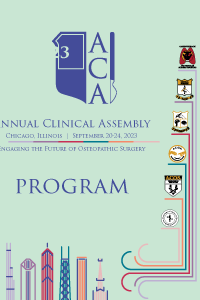General Surgery
Influenza B in pediatric bacterial tracheitis: A 13-year case series of children without artificial airways
Location: Grandball Room 1-2
- KD
Kyle Deming, MS
Rocky Vista University
Denver, Colorado, United States
Primary Presenter(s)
Introduction/Purpose: Bacterial tracheitis is a rare, life-threatening obstructive airway condition, necessitating early detection and intervention. Anecdotally, we have observed the disease is more severe during seasons with high rates of influenza B. The goal of this study is to describe a large cohort of children with bacterial tracheitis, and identify differences in illness severity based on viral etiology. We hypothesize influenza B is common in children with bacterial tracheitis and associated with more severe disease.
Methods or Case Description: After institutional review board approval, retrospective chart review was conducted from 2007-2020 at a large, tertiary care children’s hospital. Patients with pre-existing endotracheal tube or tracheostomy were excluded.
Outcomes: 30 children (17 males (56.7%)) without artificial airways were diagnosed with acute bacterial tracheitis by laryngoscopy. Mean age was 6.17 years (SD +/- 4.93). Most common presenting symptoms included stridor (86.7%), cough (83.3%) and dyspnea (80.0%). At presentation, 25 patients (83.3%) exhibited leukocytosis, and 3 (10%) were febrile. The most common viruses were parainfluenza (23.3%) and influenza B (23.3%). The most frequent bacterium was methicillin-susceptible Staphylococcus aureus (MSSA 20%, no MRSA). 12 patients (40%) required intubation and 15 (50%) required surgical management. Patients with influenza B had no significant difference in disease severity compared to children without, as measured by length of intubation (128 vs 41.6 hours (p=0.244)), length of stay (7.16 vs 3.65 days (p=0.0645)) and need for surgery (42.9 vs 68.8% (p=0.363)).
Conclusion: This represents the first study to evaluate outcomes from bacterial tracheitis in relation to viral etiology. Similar to previous literature, bacterial tracheitis was most prevalent among school-age children with stridor, cough, dyspnea and leukocytosis, and most frequently due to S. aureus. Children with concomitant influenza B had a non-significant longer duration of stay and intubation compared to children without; this result may be limited by small sample size in this rare disease.
Methods or Case Description: After institutional review board approval, retrospective chart review was conducted from 2007-2020 at a large, tertiary care children’s hospital. Patients with pre-existing endotracheal tube or tracheostomy were excluded.
Outcomes: 30 children (17 males (56.7%)) without artificial airways were diagnosed with acute bacterial tracheitis by laryngoscopy. Mean age was 6.17 years (SD +/- 4.93). Most common presenting symptoms included stridor (86.7%), cough (83.3%) and dyspnea (80.0%). At presentation, 25 patients (83.3%) exhibited leukocytosis, and 3 (10%) were febrile. The most common viruses were parainfluenza (23.3%) and influenza B (23.3%). The most frequent bacterium was methicillin-susceptible Staphylococcus aureus (MSSA 20%, no MRSA). 12 patients (40%) required intubation and 15 (50%) required surgical management. Patients with influenza B had no significant difference in disease severity compared to children without, as measured by length of intubation (128 vs 41.6 hours (p=0.244)), length of stay (7.16 vs 3.65 days (p=0.0645)) and need for surgery (42.9 vs 68.8% (p=0.363)).
Conclusion: This represents the first study to evaluate outcomes from bacterial tracheitis in relation to viral etiology. Similar to previous literature, bacterial tracheitis was most prevalent among school-age children with stridor, cough, dyspnea and leukocytosis, and most frequently due to S. aureus. Children with concomitant influenza B had a non-significant longer duration of stay and intubation compared to children without; this result may be limited by small sample size in this rare disease.

